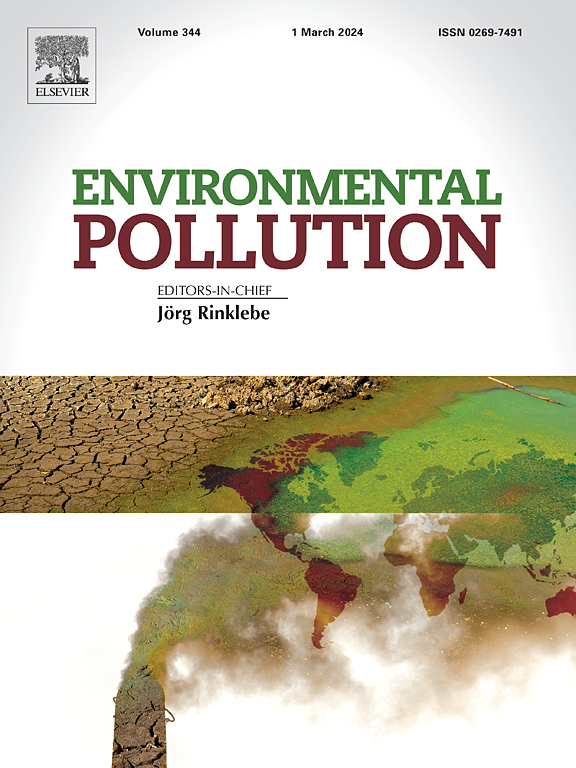Sources, temporal-spatial characteristics, exposure assessment and children health risk of phthalate esters (PAEs) in household dust in China from 2000 to 2023:a review and pool analysis
IF 7.6
2区 环境科学与生态学
Q1 ENVIRONMENTAL SCIENCES
引用次数: 0
Abstract
Phthalate esters (PAEs) have been extensively used in the household environment globally for decades, posing persistent hazards. There is significant attention on the characteristics of PAEs in household dust (HD-PAEs) in China, driven by an increasing awareness of their endocrine-disruptor toxicity. In this study, 876 peer-reviewed papers published between 2000 and 2023 were evaluated and screened for raw numerical data of HD-PAEs in residential households, including 27 papers available for final analysis. The national mean concentration of ∑8HD-PAEs was approximately 1002 mg/kg based on calculation of the samples-weighted mean concentration. Pollution levels in several provinces, including Shaanxi, Liaoning, Chongqing, Heilongjiang, Hunan, and Beijing, exceeded the national average by 230%, 209%, 151%, 84.6%, 54.7%, and 24.6%, respectively. Spatial and temporal differences were observed in HD-PAEs pollution, with DEP, DMP and DCHP exhibiting higher concentrations in northern cities (P < 0.050), while DEP and DBP demonstrated higher concentrations in winter (P < 0.050). The two principal sources of HD-PAEs were identified through correlation analysis and principal component analysis: the use of plastic products and decoration materials (DEP, DEHP, DIBP and DMP accounted for 58.6%), and personal care products (DBP accounted for 21.3%). DEHP remains the predominant HD-PAEs, despite its concentration decreasing from 2005 to 2020. The carcinogenic risk of DEHP ranged from 2.45×10-5 to 2.45×10-4, and the non-carcinogenic risk of DEHP in Shaanxi (HI = 1.05), Chongqing (HI = 1.41), and Liaoning (HI = 1.41) exceeded the acceptable levels, with dermal contact and ingestion being the primary exposure routes. Based on these findings, we recommend prioritizing environmentally friendly building materials and minimizing the use of plastic products. Proper ventilation, especially during winter, and regular household cleaning and dust removal should be implemented to enhance environmental protection in homes. These measures can effectively reduce exposure to HD-PAEs and protect the health of residents.

2000 - 2023年中国家庭粉尘中邻苯二甲酸酯(PAEs)的来源、时空特征、暴露评价及儿童健康风险综述与池分析
邻苯二甲酸酯(PAEs)在全球家庭环境中广泛使用了几十年,造成了持续的危害。随着人们对其内分泌干扰物毒性的认识不断提高,中国对家庭粉尘中PAEs的特征(HD-PAEs)的关注越来越多。本研究对2000年至2023年间发表的876篇同行评议论文进行了评估和筛选,以获取居民家庭HD-PAEs的原始数值数据,其中27篇论文可用于最终分析。经样品加权平均浓度计算,全国∑8HD-PAEs平均浓度约为1002 mg/kg。陕西、辽宁、重庆、黑龙江、湖南和北京等几个省份的污染水平分别超过全国平均水平230%、209%、151%、84.6%、54.7%和24.6%。HD-PAEs污染存在时空差异,北部城市DEP、DMP和DCHP浓度较高(P <;0.050),冬季DEP和DBP浓度较高(P <;0.050)。通过相关分析和主成分分析确定了HD-PAEs的两个主要来源:塑料制品和装饰材料的使用(DEP、DEHP、DIBP和DMP占58.6%)和个人护理用品(DBP占21.3%)。DEHP仍然是主要的HD-PAEs,尽管其浓度从2005年到2020年有所下降。DEHP的致癌风险范围为2.45×10-5 ~ 2.45×10-4,其中陕西(HI = 1.05)、重庆(HI = 1.41)和辽宁(HI = 1.41)的DEHP非致癌风险超过可接受水平,皮肤接触和摄入是主要暴露途径。基于这些发现,我们建议优先使用环保建筑材料,尽量减少塑料产品的使用。适当的通风,特别是在冬季,并定期进行家庭清洁和除尘,以加强家庭环境保护。这些措施可以有效地减少居民对高分辨率paes的接触,保护居民的健康。
本文章由计算机程序翻译,如有差异,请以英文原文为准。
求助全文
约1分钟内获得全文
求助全文
来源期刊

Environmental Pollution
环境科学-环境科学
CiteScore
16.00
自引率
6.70%
发文量
2082
审稿时长
2.9 months
期刊介绍:
Environmental Pollution is an international peer-reviewed journal that publishes high-quality research papers and review articles covering all aspects of environmental pollution and its impacts on ecosystems and human health.
Subject areas include, but are not limited to:
• Sources and occurrences of pollutants that are clearly defined and measured in environmental compartments, food and food-related items, and human bodies;
• Interlinks between contaminant exposure and biological, ecological, and human health effects, including those of climate change;
• Contaminants of emerging concerns (including but not limited to antibiotic resistant microorganisms or genes, microplastics/nanoplastics, electronic wastes, light, and noise) and/or their biological, ecological, or human health effects;
• Laboratory and field studies on the remediation/mitigation of environmental pollution via new techniques and with clear links to biological, ecological, or human health effects;
• Modeling of pollution processes, patterns, or trends that is of clear environmental and/or human health interest;
• New techniques that measure and examine environmental occurrences, transport, behavior, and effects of pollutants within the environment or the laboratory, provided that they can be clearly used to address problems within regional or global environmental compartments.
 求助内容:
求助内容: 应助结果提醒方式:
应助结果提醒方式:


